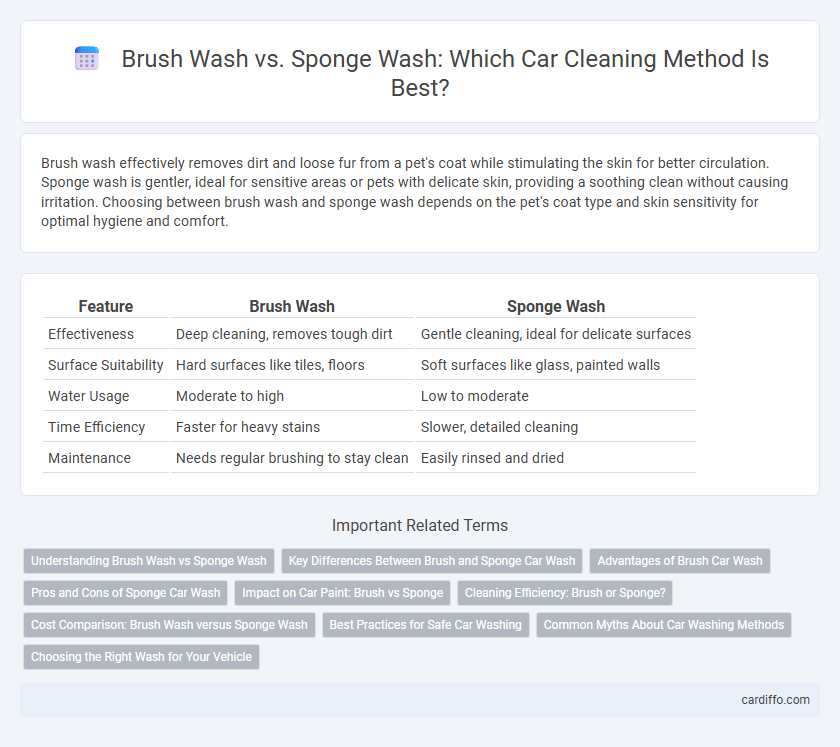Brush wash effectively removes dirt and loose fur from a pet's coat while stimulating the skin for better circulation. Sponge wash is gentler, ideal for sensitive areas or pets with delicate skin, providing a soothing clean without causing irritation. Choosing between brush wash and sponge wash depends on the pet's coat type and skin sensitivity for optimal hygiene and comfort.
Table of Comparison
| Feature | Brush Wash | Sponge Wash |
|---|---|---|
| Effectiveness | Deep cleaning, removes tough dirt | Gentle cleaning, ideal for delicate surfaces |
| Surface Suitability | Hard surfaces like tiles, floors | Soft surfaces like glass, painted walls |
| Water Usage | Moderate to high | Low to moderate |
| Time Efficiency | Faster for heavy stains | Slower, detailed cleaning |
| Maintenance | Needs regular brushing to stay clean | Easily rinsed and dried |
Understanding Brush Wash vs Sponge Wash
Brush wash uses a stiff-bristled brush to deeply clean surfaces by scrubbing away dirt and grime, making it ideal for textured or heavily soiled areas. Sponge wash relies on a soft, porous sponge that gently lifts dirt without damaging delicate surfaces, perfect for light cleaning and sensitive materials. Selecting between brush wash and sponge wash depends on the surface type and level of dirt, ensuring optimal cleaning efficiency and surface protection.
Key Differences Between Brush and Sponge Car Wash
Brush car washes use rotating brushes with stiff bristles that effectively remove dirt and grime from the vehicle's surface but may cause minor scratches or swirl marks over time. Sponge car washes involve manual application of soapy water with soft sponges, offering gentler cleaning that reduces the risk of paint damage while requiring more time and physical effort. The key difference lies in the balance between efficiency and surface care, with brush washes being faster and more automated, whereas sponge washes prioritize careful detailing and minimizing abrasion.
Advantages of Brush Car Wash
Brush car washes offer superior cleaning power by effectively removing dirt and grime from all vehicle surfaces, including hard-to-reach areas like wheel wells and undercarriages. They use rotating brushes that provide consistent pressure and coverage, ensuring a thorough clean without damaging the paint when maintained properly. Compared to sponge washes, brush car washes save time and deliver a more uniform finish, making them ideal for routine vehicle maintenance and enhancing overall vehicle appearance.
Pros and Cons of Sponge Car Wash
Sponge car washes offer gentle cleaning, reducing the risk of paint scratches caused by abrasive brushes, making them ideal for delicate finishes and classic cars. However, sponges can trap dirt particles, increasing the potential for swirl marks if not properly rinsed and maintained. Their slower cleaning process requires more effort, but provides better control over targeted areas, enhancing detailed washing results.
Impact on Car Paint: Brush vs Sponge
Brush wash offers a more aggressive cleaning action that effectively removes stubborn dirt and contaminants but can cause microscopic scratches or swirl marks on car paint if not used properly. Sponge wash provides a gentler touch that reduces the risk of damaging the paint surface, preserving the car's clear coat integrity and shine. Choosing between brush and sponge wash depends on balancing thorough cleaning with minimizing paint abrasion for long-term vehicle aesthetics.
Cleaning Efficiency: Brush or Sponge?
Brush wash offers superior cleaning efficiency due to its firm bristles that effectively remove dirt and grime from surfaces, reaching into crevices for a thorough cleanse. Sponge wash provides gentler cleaning suitable for delicate surfaces but may require more effort to eliminate stubborn residue. Choosing between brush and sponge wash depends on the surface type and desired cleaning intensity for optimal results.
Cost Comparison: Brush Wash versus Sponge Wash
Brush wash techniques often involve higher upfront costs due to the need for specialized brushes and maintenance, but they tend to offer longer lifespan and durability, making them cost-effective over time. Sponge wash methods typically require frequent replacement of sponges, increasing recurring expenses despite lower initial investment. Evaluating total cost of ownership, brush wash proves more economical for large-scale or frequent washing applications, while sponge wash suits lower-frequency use with minimal initial budget.
Best Practices for Safe Car Washing
Using a brush wash can effectively remove stubborn dirt from your car's surface, but it requires a soft-bristled brush to avoid scratching the paint. Sponge wash is gentler and ideal for daily cleaning, as it allows for controlled pressure and better coverage of delicate areas. Best practices for safe car washing include using a two-bucket method, rinsing frequently, and choosing pH-balanced car wash soaps to protect the vehicle's finish.
Common Myths About Car Washing Methods
Many drivers believe that brush wash methods can damage a car's paint, though modern brushes designed with soft bristles minimize this risk. Sponge wash is often thought to be gentler, but if sponges are not regularly cleaned, they can trap dirt particles that cause micro-scratches. Understanding these myths helps in choosing the most effective and safe car washing technique for maintaining vehicle appearance.
Choosing the Right Wash for Your Vehicle
Brush wash systems use rotating brushes with soft bristles to effectively remove dirt and grime from vehicle surfaces, making them ideal for heavy-duty cleaning. Sponge wash options provide a gentler touch, minimizing the risk of scratches, which suits delicate paint or luxury vehicles. Selecting the right wash depends on your car's finish sensitivity and the level of dirt accumulation.
Brush Wash vs Sponge Wash Infographic

 cardiffo.com
cardiffo.com